For a wider explanation of matters outlined under the first three headings here, please see the book.
Anagrammatic Dispersion
To convey an otherwise secret component of their message, the gospel authors rely upon riddles configured for the capable reader to solve.
Key amongst the methods employed is anagrammatic dispersion, where selected words are concealed within other words. This is rather easy to do, as some examples in English will show:
- The name PAUL may be concealed by writing the word ' PeAcefUL' { within }
- The name JAM ES may be concealed by writing the word ' MAJ EStic' { within and backwards }
Many will be surprised to learn of the role this method plays in conveying the gospel message. For no one can teach what he does not know himself, and ever since the gospels were written few have been in any position to explain it. Then the gospels were written in classical Greek, so it is only when we read in Greek that we are able to see how extensively the method has been used, and to what effect.
In fact it's a method directly disclosed via a passage in the Book of Revelation which appears to allude to the Bible itself as "a book written within and backwards, sealed down with seven seals" [Rv.5:1-4]:
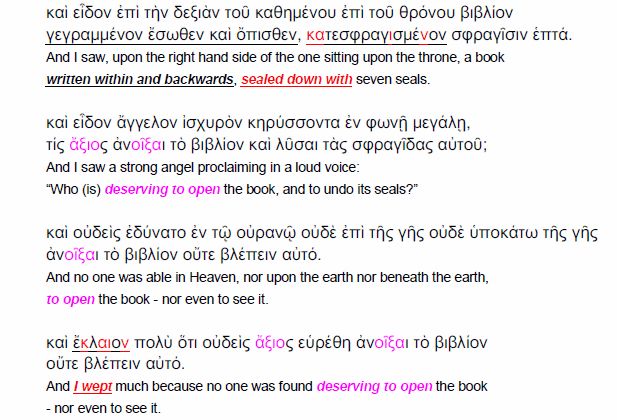
There you can see examples of writing in Greek that has been formed within and backwards.
Notice how the play upon AXIO...OIXA is repeated, a reflection of the writer's anxiety that each of his readers should notice what has been done, and should learn from it - in this way qualifying "to open the book, and to undo its seals".
The same practice is alluded to at 1 Cor.13:12, with the assertion that "Now we see through a mirror, within a riddle... ". How unfortunate then, and how ironic, that the translators of the English King James Bible [KJV : 1611] should have bowdlerised this passage with the misguided phrase: "For now we see through a glass darkly...".
But what was the intention of the evangelists when they wrote in this way?
The answer begins to emerge when we realise (see below) that amongst the words selected for this treatment were the names properly intended by the writers for the key players in their narrative.
It follows that these characters go effectively 'in disguise'... until such time as the reader learns to recognise the names of those concerned, hidden away within other words.
For example, in the passage cited above you should be able to make out the name of KAIN ( Cain ) dispersed within the word ' KATESFRAGISMENON' ( sealed down with ).
We can see it again in the word ' EKLAION' ( I wept ).
Yet as with any treasure hunt, you will not find what's been hidden unless you first know what you are supposed to be looking for. Thus the 'true' identities intended for the key protagonists in the gospel narrative are withheld from the many readers who have no idea what has been hidden, let alone how it's been done. For them the consequence is that the characters concerned go 'hidden from their face', precisely as Cain threatens in the narrative at LXX Gn.4:13-14 (after he has killed his brother Abel) :
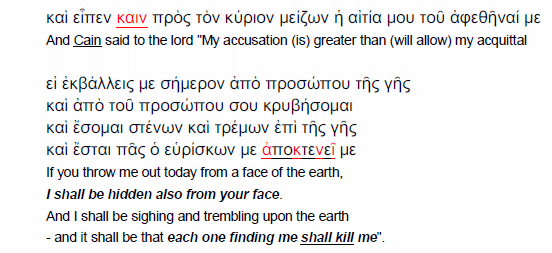
Now it should be clear that with this technique of anagrammatic dispersion we have a handy method, available for use by any writer in any language, for concealing a second component
of meaning behind the literal narrative of a text.
But with it being used in the gospels, even readers in Greek will be tantamount to blind if they do not know what to look for. And now, having failed to find what has been hidden, they are all to be led astray by following the 'straight way' [qv. Mt.3:3, Mk.1:3, Lk.3:4-5, Ac.9:11, Ac.13:10] presented in the core of the narrative... all the while failing to recognise which persons in the story have been cast as good, and which have been cast as evil.
Those who place their trust in translations will also be numbered amongst the blind - for by setting aside the Greek, they forfeit from the outset their chance to see what the writers have left hidden in the original text. For them, the resulting information loss turns out to have disastrous consequences, and it's highly probable they too will go on to misconstrue the message conveyed by the gospels.
On both counts such 'blindness' was already widespread by the time the Catholic church was established in the 4th century CE under Constantine. And there has been almost no recovery since, with the same blindness to the gospels continuing to blight the lives of millions in our age.
For this is what so many miss, from pauper to pope - (a) that the 'straight way' has been configured by the evangelists as the way that leads to perdition [Mt.7:13-14]; and (b) that in the gospels it is standard practice to conceal the names of those who spell trouble. For example:

Note: The phrases cited above are taken direct from the following verses in the gospels and NT letters:
[1] Mt.14:20, 16:9; Mk.8:19; Jn.6:13
[2] Jn.15:22
[3] Jn.11:25
[4] Mt.10:40; Mk.9:37; Lk.9:48, 10:16
[5] Lk.22:20, 1Cor.11:25
[6] Mk.15:17; Jn.19:5
It is explicit elsewhere that the serpent is Satan [Rv.12:9, 20:2]. Moreover Jewish tradition asserts that Cain is the offspring of the serpent [Gn.4:1], a point apparently confirmed by the NT passage at 1Jn.3:12. That this is the identity properly intended for Jesus is fully confirmed by the reference at Col.1:15 to Jesus as "firstborn of all creation" - a unique descriptor for Cain.
In fact the gospel authors consistently portray Jesus to be Cain-in-disguise. But in line with their convention that Cain goes always 'hidden from your face', they stop short of naming him directly. Instead they rely upon riddle techniques as the means by which intelligent readers may penetrate the secret core of their 'mystery', recognising that Jesus is Cain.
Indeed all that pertains to ' the kingdom of the heavens' is declared in the gospels to be 'hidden', eg. with the riddles at Mt.13:33, 13:44. Then in the narrative Jesus says of the 'Father' that "he has hidden things from the wise and the learned, and revealed them to infants " [Mt.11:25; Lk.10:21]. The assertion tends to suggest that the technique for hiding things is really quite simple - as in fact it is.
Finally, we hear Jesus declare that what has been hidden will be found [Mt.10:26; Mk.4:22; Lk.8:17, 12:2]. Indeed a knowledge of what has been hidden, and how this has been done, is vital to every reader of the gospels.
How remarkable, then, that so few know these things in our age.
The Sign for Cain
Examples [5] and [6] above, where the name of Cain may be found embedded in other words, have their root in the Greek text of Genesis, the version familiar to those who actually wrote the gospels. It is there that the sevenfold 'sign' for Cain is first declared... and immediately demonstrated by having Cain's name appear, overtly and hidden, seven times in that same passage.
Here you can see for yourself how it's done [LXX Gn.4:15-16]:
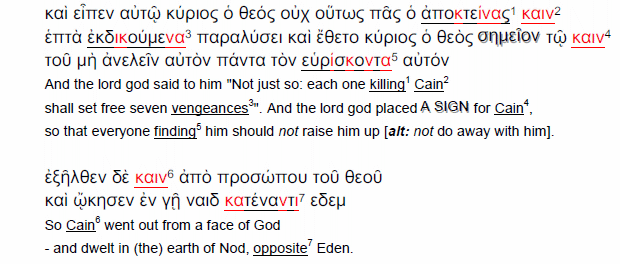
Already Cain has threatened: "I shall be hidden also from your face ". The episode now closes with: "Cain went out from a face of God ". The technique of anagrammatic dispersion is simply a smart way for the writers to achieve this, and the passage above constitutes a straightforward 'declaration of intent'.
Subsequent use of this 'sign' in LXX Genesis brings the total of instances to 490, the same figure (seventy times seven) given at LXX Gn.4:24, and again at Mt.18:20-22.
Then in the fourth gospel we find the 'sign' for Cain deployed 153 times, the same figure given in the final chapter as the count of 'big fish' successfully landed [Jn.21:11]. It is by means of such checksums that the solution to scripture's deeper mystery is confirmed to the competent student.
Identifying Jesus
In the allegorical passage at Mt.26:20-46, the actions taken by Jesus match those previously ascribed to Cain. Following the Eucharistic meal, evidently a sacrifice 'from the fruits of the earth' [Gn.4:3], Jesus goes out to the Mount of Olives. There he becomes sad and falls to his face. It is precisely the behaviour of Cain [Gn.4:5].
He pleads with the one he addresses as 'Father' that his 'cup' should be accepted. Yet notice he must make this prayer three times, once again evoking the frustration of Cain whose 'sacrifice' God disdains [Gn.4:5].
Ironically, the disciples with Jesus fall asleep. As a result, and like so many readers of the gospel, they fail to notice what is signified by the behaviour that Jesus displays.
Finally, the gospel narrative reports how Judas agrees to give away the identity of Jesus. But this is the point where the evangelist himself is about to give away - to attentive readers in every age - the identity he properly intends for Jesus. He will do this by deploying the 'sign for Cain'. So once again we are about to 'learn' the otherwise secret identity of Jesus... but now it will be from the mention of thirty pieces of silver and a good opportunity [Mt.26:14-16] :
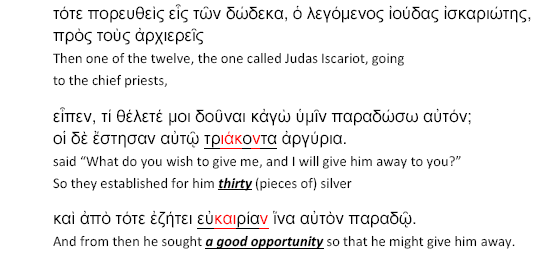
Finally the moment comes for Judas to identify Jesus. He will do this by means of a sign - a sign that takes the form of a kiss [Mt.26:48-49] :
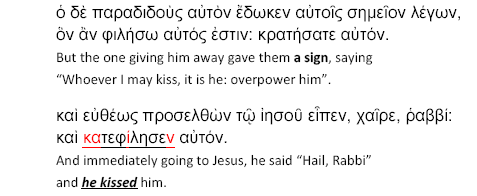
At the critical point of the encounter we find in the Greek text the word:
The writer of the gospel has extended to his readers the means to identify Jesus for themselves... unerringly by means of this simple device.
Then Roman governor Pontius Pilate, also recognising Jesus, seeks to let him go [Lk.23:14-16].
Ironically the priests and the crowd do not know the sign. Blindly ignorant of Jesus' proper identity [qv. Acts 13:27], they go on to procure his crucifixion [Acts 13:28]. In this way Cain's own prediction is achieved. For, as we have seen above, Cain says in Genesis: "I shall be hidden also from your face" and "Each one finding me shall kill me" [Gn.4:14].
It is in the narrative of the gospels that he is killed, and at the hands of those who do not know the sign.
And now for something truly clever. The Greek word for "he kissed" [Mt.26:49, Mk.14:45, Lk.15:20] conceals more than just Cain's name:

So was this second anagrammatic reading also intended by those who wrote the gospels?
It seems likely it was, for a HEAD holds special significance. It is something readers are expected to look out for, as directed in the curse upon the serpent configured at LXX Gn.3:15:
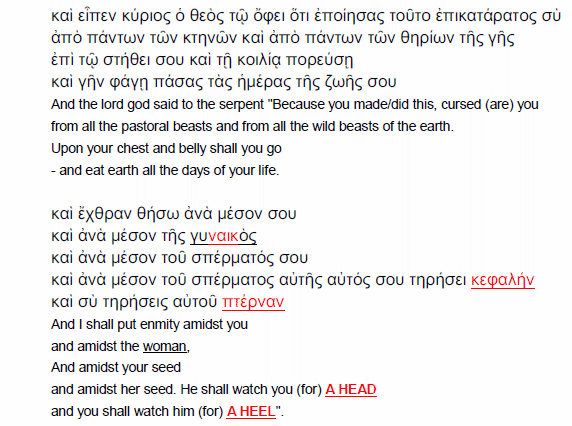
Notice that the curse here is NOT imposed by God, it is imposed by the 'lord god'.
Those who comprise the 'seed' of the woman are to watch (in their own defence) for A HEAD... this being the token of a serpent. And the reference is to 'He', implying that those who are to 'watch out' are the male descendants of the woman (the woman herself is thus excluded, presumably because she has already been deceived by the serpent).
Whereas the serpent, and presumably by extension any 'seed' thereof, is to 'watch' for A HEEL... this being the token of any person not deceived by him, and thus well placed to crush his head.
It follows that mention of A HEAD in the texts of subsequent scripture provides us with a label by which we may instantly recognise the activity of any character the authors have decided to 'mark' as a serpent.
Jesus himself, as Cain-born-again, emerges as the foremost example here - as manifested with startling clarity in the passage at Jn.13:3-18 where each disciple in turn raises his HEEL above the HEAD of Jesus. Then to wash the feet of his disciples, Jesus has already removed his clothes and stoops almost naked before them ("upon your chest and belly shall you go").
Saussure's Anagrams
Swiss scholar Professor Ferdinand de Saussure [1857-1913] taught at the universities of Geneva and Paris and is widely considered the founder of modern linguistics. In the course of studying Saturnian verse, and similar Latin poetry roughly contemporaneous with LXX Genesis, he deduced that the writers invoked anagram methods as the means to conceal certain words in their text.
These methods rely upon the compositional technique known alternatively as anagrammatic dispersion, transpositional encryption, or sometimes metathesis
In The Cambridge Companion to Saussure [CUP, 2004, ISBN:978-0-521-80486-8], Peter Wunderli writes (p.177): "The question, however, arises of how we know which elements are liable to be anagrammatised. Saussure's answer was that it would normally be a name or a word of central importance for the text. Since the anagram technique appears to have its origins in religious literature, the most likely candidate is the name of god invoked by the poet, and strenuous efforts are made accordingly to discover his 'presence' in the text."
In his 2006 paper linked here: Wordplay in Vergil and Claudian, Professor Damien Nelis (University of Geneva) gives some simple examples of the anagram technique manifested in the Latin of Vergil and Claudian. He goes on to point out how these writers issue a 'signal' to draw the attention of the reader to significant anagram wordplay deployed in the nearby text.
To give just one example from the many possible, the use of the signal dispersum (dispersed), at Aeneid 8 line 321, is directly paralleled by the use of
![]() (dispersion) in the gospel at Jn.7:35. Yet those who insist on reading the gospels in translation will
never see the hidden names pointed to by such 'signals'. Instead they remain blind to the identity properly intended by the authors for Jesus himself; and on the oversight which
results, the doctrinal claims of the Christian church fail in their entirety.
(dispersion) in the gospel at Jn.7:35. Yet those who insist on reading the gospels in translation will
never see the hidden names pointed to by such 'signals'. Instead they remain blind to the identity properly intended by the authors for Jesus himself; and on the oversight which
results, the doctrinal claims of the Christian church fail in their entirety.
It appears that this compositional method was quite widely exploited by writers in the classical age. It should therefore come as no surprise when we find it deployed in the gospels.
In conclusion
Not only are the gospels plainly fiction, being four parallel sequels themed upon the book of Genesis, but consistently the authors portray Jesus as Cain. He has "entered a second time into his mother's womb and been born again " [qv. Jn.3:4]. And now he goes "hidden from your face " [Gn.4:14].
The Christian church, failing to recognise who this is [Mt.16:13, Mk.8:27, Lk.9:18], insists on embracing Cain as if he were somehow good.
Yet Cain is deemed to be evil [LXX Gn.4:1 => 1Jn.3:12]. He is the offspring of the serpent, who is Satan. He has killed his brother Abel. And it is the central theme of the gospels that in retribution he will himself be killed [LXX Gn.4:14 => Mt.17:23, Mk.9:31, Lk.18:33].
Unfortunately the Christian tradition "understands none of these things; this word was hidden from them, and they did not learn to know what was said" [ Lk.18:33-34 ]:
It is ignorance of what a gospel really is - of how it extends the theme of Genesis, making real for every reader their own personal encounter with the scriptural serpent who seeks to deceive them with the HEADY promise of 'eternal life' - that leads Christians unwittingly to embrace as their god the fictional figure consistently set forth in scripture as 'Satan'.
They could make no greater mistake. For this is the duplicate deity brought into being at Gn.1:27, not the good God pre-existing at Gn.1:1.
The same combination of philosophical, cultural, logical and linguistic incompetence leaves the Christian church(es) crippled at every turn. Even what they have will be taken from them - as anyone who succeeds in penetrating the 'mystery' set forth in the gospels must surely appreciate.
Mt.13:10-17
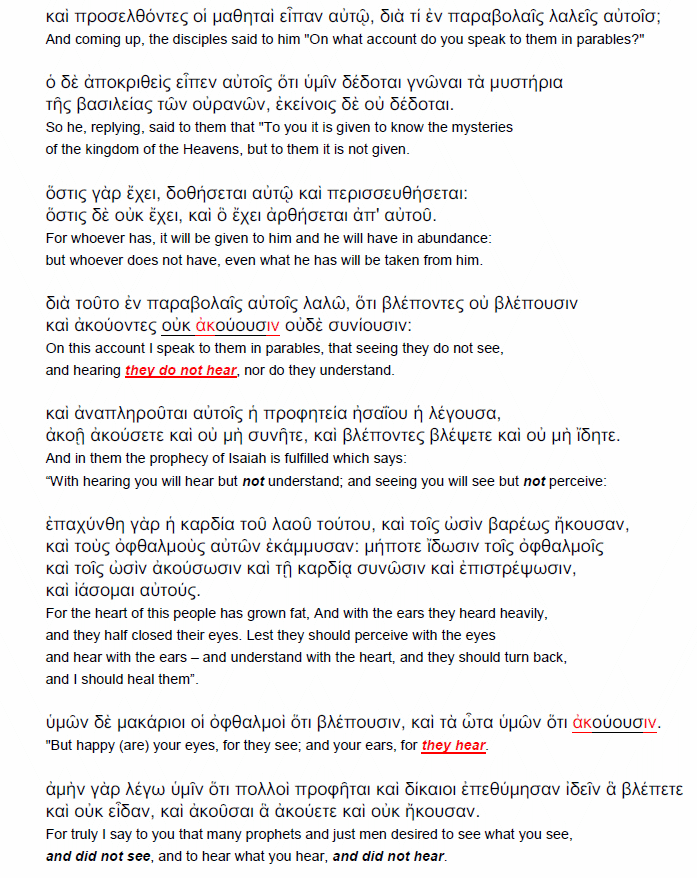
J H Hatfield : 02 December 2012

